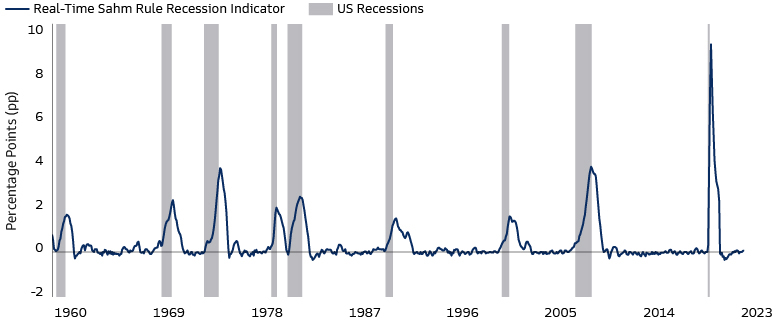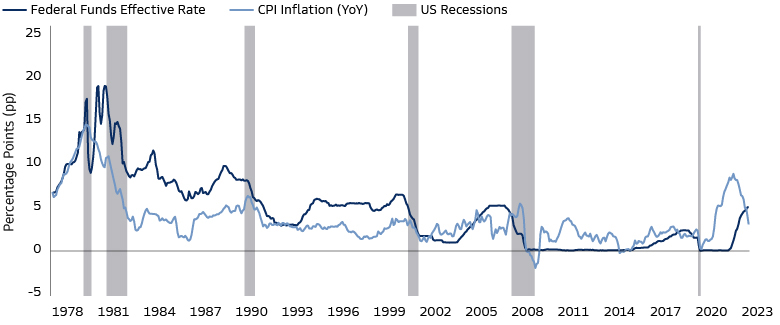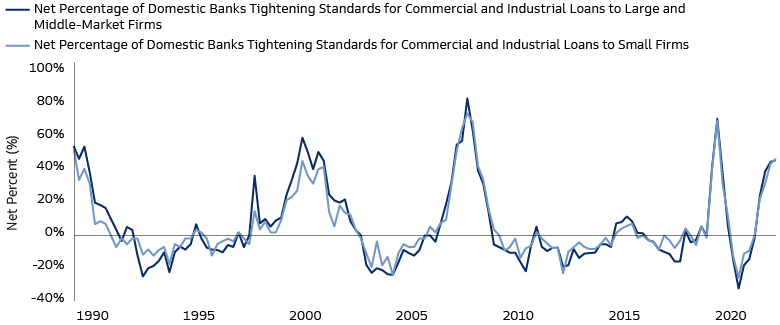Seizing Late-Cycle Opportunities
Economies move in cycles, and each cycle brings its own challenges and opportunities. In many aspects, the current cycle has shown signs of aging and we are likely in late cycle. As investors debate the chances of growth or recession, we think the journey merits its own consideration. Staying on the sidelines could prove costly, while we believe an active, diversified approach across public and private markets may be the best way to navigate near-term uncertainties and seize late-cycle opportunities.
Late Cycle, Not End Cycle
Some Macro Data Has Slowed, but Not Enough for a Recession
For over a year, the Federal Reserve (Fed) has embarked on aggressive rate hikes—along with balance sheet reduction—to combat stubbornly high inflation. Price pressures in the US have started to ease heading into the second half of 2023. Among the key components, core goods inflation has decelerated the most as supply chain pressures eased, shelter inflation has started to level off in recent months, core services ex-shelter inflation has moderated to some degree yet remains the key risk to our inflation outlook.1 Gradual and uneven progress on disinflation suggests to us that humility is required in forecasting future levels from here, even when most of the key drivers appear to be moving in the right direction.
Drags from persistent inflation and cumulative policy tightening have slowed growth to a soft, but non-recessionary pace. The US labor market’s momentum has started to fade—the quits rate has steadily declined since 2022 and dropped to 2.4% in April, just above its 2018-2019 level of around 2.3%. Despite a mild uptick in May, the downtrend over past 12 months indicates that opportunities for switching to better jobs have been diminishing.2 Wage growth has begun to slow, but further deceleration is likely needed to be consistent with the 2% inflation target. At the aggregate level, the US unemployment rate has not risen much beyond its pre-pandemic level of 3.5%. According to the Sahm Rule, which states that we are in the early months of recession when the three-month moving average of the national unemployment rate is 0.5% or more above its low over the prior twelve months, the US economy is not yet in recession as it heads into the second half of 2023.

Sahm, Claudia. Real-time Sahm Rule Recession Indicator, Federal Reserve Economic Data. Federal Reserve Bank of St. Louis. As of July 14, 2023. For illustrative purposes only.
This doesn’t necessarily mean the economy will avoid a downturn altogether. As monetary policy has continued to tighten, shorter-dated interest rates have risen beyond longer-dated ones, leading to an inverted yield-curve—typically an indicator for an impending recession. Heading into the second half of 2023, the spread between 2- and 10-year Treasuries has inverted to the deepest levels since the early 1980s; other measures of yield curve inversion are also pointing to meaningful recession odds. However, yield curve inversion alone is not particularly informative about the timing of an upcoming recession, and there are meaningful downside buffers that may forestall the economy from tipping into a downturn imminently and prolong the duration of the current cycle.
Despite strong headwinds and signs of weakness, the US economy has proven resilient so far in 2023. Many of the upside surprises in the economic activity data have pertained to consumer spending. Goods consumption rebounded quickly in the first quarter to the fastest pace since the second half of 2021, and services consumption remains strong.3 The combination of a strong labor market and solid real disposable income growth could continue to support consumer spending—and therefore economic growth—in the months ahead.
The balance sheets of US households, corporates, and state and local governments also remain solid at the midway point of the year. Moreover, the tail risk of the debt limit crisis has been eliminated and, so far, stress in the US regional banking system is expected to impose a moderate but not recessionary drag on growth. There are signs that bank lending standards have tightened across several types of loans, while the extent of further credit tightening remains uncertain. Fiscal policy bills, such as the CHIPS Act, may further spur manufacturing investments and provide offsets to credit tightening.
Higher Rates for Longer
We believe the outlook for any further hikes will likely depend on whether labor market rebalancing has progressed far enough to solidify disinflation. In June, the Fed dots projected two additional hikes left for this year,4 which was viewed as a hawkish surprise by markets. Yet despite the aggressive pace of hikes, the level of Fed Funds rate has only recently risen to levels comparable to inflation. This contrasts with historical hiking cycles when the Fed hiked rates well above inflation. Therefore, we continue to expect that US monetary policy will stay restrictive for longer. Such an environment is expected to be particularly challenging for business models that rely on higher leverage, lower cost of borrowing and ample liquidity. On the flip side, however, this may also represent an opportune time to be a lender, particularly in private markets.

Federal Reserve Economic Data. Federal Reserve Bank of St. Louis. As of July 14, 2023. For illustrative purposes only.
Seizing Opportunities
Considering the Fed’s hawkish stance, the timeframe for a monetary policy pivot and the duration of the late-cycle phase remains highly uncertain. But rather than sitting on the sidelines and waiting for the cycle to turn, we believe staying invested with an active, diversified approach may be the best way to navigate uncertainty and seize late-cycle opportunities in the meantime.
Private Credit: Be a Lender
In a higher-for-longer rate environment, we see opportunities for investors to earn equity-like returns in private credit. Compared to public fixed income, private credit involves directly providing loans to companies in privately negotiated transactions. The strategy can offer incremental income generation and greater resiliency during periods of heightened volatility, serving as a potentially strong complement to traditional fixed income. The current environment is buoying private credit yields—the average new-issue yield across all US leveraged loans reached 10.2% in 2Q 2023, the highest since 2009.5 This is being driven by borrowers willing to pay more for the certainty of execution and custom terms that private lenders offer. Rising rates and market volatility have led to a slowdown in high yield and leveraged loan issuance, as lenders, including smaller domestic banks, curtail their activity. Private credit has stepped in to fill the gap, expanding the strategy’s share of corporate and real asset lending, particularly across segments of commercial real estate facing tighter credit conditions, income pressure and elevated refinancing needs.

Federal Reserve Economic Data. Federal Reserve Bank of St. Louis. As of July 14, 2023. For illustrative purposes only.
Private lenders today have the benefit of being able to focus on high-quality borrowers with attractive coverage ratios and favorable terms to mitigate downside risk. As interest rates have climbed, private credit loans are offering equity-like returns in the double digits and, in general, private credit terms tend to include bespoke protections and provisions not found in the high yield or leveraged loan market.6 Private credit portfolios can also select investments without the need to manage to a benchmark. Selectivity can be a key advantage—and a potential downside mitigant—in an environment of increased dispersion, slowing growth, tightening monetary policy and headwinds to profitability. As the asset class matures, we believe private credit is becoming an increasingly viable replacement for traditional leveraged finance providers, offering increasing scale, customization, and certainty to borrowers that often view these benefits as compensation for the higher cost of capital.
Fixed Income Resilience
One upside of the transition to a higher rate regime is that the forward income and total return potential of core bonds, such as high-quality government bonds, has improved significantly. They have also delivered positive returns in past recessions and may act as an important ballast to portfolios should an adverse scenario materialize in this cycle.7 Further, core bonds have tended to have a low or negative correlation with equities and other risk assets which drives potential diversification benefits. Given the backdrop of late cycle economy, close to peak hiking cycle, and attractive level of real yield, we find long-duration US Treasuries attractive. Overall, we remain cautious on US credit, but continue to believe that there is opportunity for active management in this space. The recent banking crisis is expected to push US banks to tighten lending standards further and we do not believe this tightening is fully reflected in credit spreads, which are only at median levels over the cycle and not yet an attractive point of entry. Nonetheless, investors should continue to be mindful of security-level relative value and market dislocations that may present idiosyncratic opportunities, and active security selection remains crucial.
Equities: Keep Your Options Open
This year, market positioning appears to be cautious on risk assets, and positioning surveys point toward net underweight allocation of global equities at mid-year point. The US equity market currently embeds two different dynamics. On one hand, mega-cap tech stocks are being driven by high growth expectations as equity investors debate the influence generative AI may have on the future revenue growth and profitability of companies, and the valuation of stocks. On the other hand, the rest of the market is inching higher instead of rallying sharpy as inflation outlook and market sentiment improves. Currently, the valuation of tech remains within historical ranges and well below the peaks of early 2000s.8 Besides, with equity volatility at multi-month lows, the cost of downside mitigation has also become attractively cheap. Considering the macro backdrop, equity fundamentals, market pricing and positioning, we prefer to stay invested in equities with some hedged exposures.
AI Disruption May Lead to Active Management Opportunities
The ability and accessibility of generative AI models and their implications for creating well-crafted content, from persuasive rhetoric to code, has accelerated exponentially. We expect the integration of AI within enterprises and wide scale adoption by consumers may have a huge impact on societies and economies over the coming years. As investors, we believe AI is a growth driver with a wide variety of applications and is on a path to disrupting entire industries as we currently know them. In our view, companies that are harnessing generative AI to enhance their business, leveraging predictive AI to make their business smarter, and those manufacturing the hardware to enable the proliferation of AI are set to disproportionately benefit. In our view, each business will need a clear strategy to incorporate AI if they want to remain a market leader. We find this is a particularly exciting time to be evaluating AI opportunities. Finding the next generation of winners will likely require investors to be nimble and look beyond benchmarks.
Diversification Matters in a Dislocated Global Cycle
The beginning of the current monetary tightening cycle featured synchronized deployment of policy measures in most major economies, but the finale may reveal more differentiated responses as growth and inflation trajectories regionally diverge. While the Fed may be approaching the end of its hiking campaign, further tightening may be required by the European Central Bank (ECB) and Bank of England (BoE) to keep a lid on prices. Contrary to the hawkish stance of other G4 central banks, the Bank of Japan (BoJ) has remained accommodative for an extended period of time. Considering strong domestic demand, we continue to see diversification opportunities in Japanese equities. Beyond advanced economies, emerging markets are moving at their own pace, resulting in a desynchronized global cycle. Emerging market growth momentum remains soft but is no longer deteriorating. Inflation has plummeted in some countries, for example Brazil, Chile, and Mexico. Most EM central banks have reached the end of their respective hiking cycles, and the first EM central banks have begun their easing cycles. High real yields, weak currencies, low inflation may support diversification opportunities in local currency government bonds.
China’s cycle is also distinctively dislocated from most developed markets, with the People’s Bank of China (PBoC) in easing mode. China's economic activity has rebounded following the lifting of mobility restrictions, but the boost from re-opening has been fading, with macro data missing market expectations coming into the second half of 2023.9 In our view, China’s recovery is likely to be non-linear from here. We believe the country remains a large, growing market with a vast opportunity set, though there is also an important shift in foreign direct investments occurring from China to countries such as Vietnam, India, and Mexico. Besides, US-China geopolitical gyrations may also create a more uncertain environment. Overall, we think a diversified, active approach is key to capitalize on investment opportunities in a dislocated global cycle with differentiated drivers at the country level.
Watch for the Next Phase of the Cycle
As cycles turn, investment opportunities shift. We continue to monitor closely the balance of risks between the economy’s strength and vulnerabilities, as they provide more clues on where we are in the journey toward the future stages of the business cycle. The upcoming quarters are likely key in revealing global central banks’ degree of success in bringing down inflation, the future path of monetary policy, as well as to what extent balance sheet resilience and fiscal programs may offset drags from interest rate and credit tightening. But uncertainty and disruption present opportunities for long-term investors. In our view, market participants should remain vigilant to growth and inflation dislocations across economies—as well as trends that transcend cycles—and stay invested, seizing late-cycle opportunities where they can be found.
1US Bureau of Labor Statistics. As of July 7, 2023.
2US Bureau of Labor Statistics. As of May 31, 2023.
3US Bureau of Economic Analysis. As of June 30, 2023.
4Federal Reserve. As of June 14, 2023.
5LCD, “Amid credit tightening, leveraged loan market revisits Financial Crisis levels” As of June 7, 2023
6 Cliffwater Direct Lending Index. Analysis of the unlevered, gross of fees performance of U.S. middle market corporate loans. As of June 30, 2023
7Bloomberg, Datastream and Goldman Sachs Asset Management. Analysis of German, UK, US and Japan government bonds annualized total return in local currency from March 31, 1980 to March 31, 2023.
8I/B/E/S and Datastream. As of July 19, 2023.
9National Bureau of Statistics of China. Bloomberg. As of July 17, 2023.
